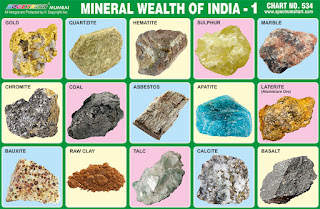 |
| Mineral Wealth of India 1 Chart |
Spectrum Chart - 534 : Mineral Wealth of India 1
1. Gold - Gold
is a transition metal and a group 11 element. It is one of the least
reactive chemical elements and is solid under standard conditions.
The metal therefore occurs often in free elemental form, as nuggets
or grains, in rocks, in veins and in alluvial deposits. Consumption
of gold produced is about 50% in jewellery, 40% in investments and
10% in industry.
2. Quartzite - Quartzite is formed when
grains of quartz sand melt together under high heat and extreme
pressure. While most quartzite is white or grey, if the sand
contained iron oxides, then the quartzite formed can be a nice shade
of soft pink or rose. The resulting rock is very hard and very
uniform in its texture.
3. Hematite - Hematite is the mineral form
of iron oxide (Fe2O3), one of several iron oxides. Hematite
crystallizes in the rhombohedral lattice system and it has the same
crystal structure as ilmenite and corundum. It is mined as the main
ore of iron. Hematite is harder than pure iron, but much more
brittle.
4. Sulphur - Sulphur (S) is a bright
yellow non-metallic element with an atomic number of sixteen. Sulphur
occurs naturally as an element but can also be found in a number of
compounds and minerals. Sulphur is vital for living organisms.
5. Marble - Marble is a metamorphic rock
that is formed when limestone or dolomite is exposed to the right
heat and pressure conditions. Marble has a uniform texture when it
forms and is sought after as a building material for its strength,
its beautiful striations and colours and its sheen when polished.
6. Chromite – Chromite is an iron
chromium oxide. It is an oxide mineral belonging to the spinel group.
It is by far the most industrially important mineral for the
production of metallic chromium, used as an alloying ingredient in
stainless and tool steels. The chromium extracted from chromite is
used in chrome plating and alloying for production of corrosion
resistant superalloys, nichrome and stainless steel. It is also
sometimes used as a gemstone.
7. Coal - Coal is a combustible black or
brownish-black sedimentary rock usually occurring in rock strata in
layers or veins called coal beds or coal seams. Coal is extracted
from the ground by coal mining. Coal is primarily used as a solid
fuel to produce electricity and heat through combustion. It is also
used as a source of heat for manufacturing processes.
8. Asbestos – Asbestos is a set of six
silicate minerals which occur naturally. It occurs in all parts of
the world. It is fibrous, heat resistant and non flammable. These
properties made it very attractive as a component in building
materials and other products such as insulation and automobile brake
pads. Asbestos was linked to lung cancer in the early 1970's and was
replaced by other materials in most applications by 1980.
9. Apatite – Apatite is a group of
phosphate minerals, usually referring to hydroxylapatite,
fluorapatite and chlorapatite, with high concentrations of OH−,
F− and Cl− ions, respectively, in the
crystal. Apatite is one of a few minerals produced and used by
biological micro-environmental systems. Apatite is the defining
mineral for 5 on the Mohs scale.
10. Laterite (Aluminium Ore) – Laterite
is a soil and rock type rich in iron and aluminium and is commonly
considered to have formed in hot and wet tropical areas. Nearly all
laterites are of rusty-red coloration, because of high iron oxide
content. Laterites are a source of aluminium ore. The majority of the
land area containing laterites is between the tropics of Cancer and
Capricorn.
11. Bauxite - Bauxite, an aluminium ore, is
the world's main source of aluminium. Bauxite is a rock formed from a
laterite soil that has been severely leached of silica and other
soluble materials in a wet tropical or subtropical climate. Almost
all of the aluminium that has ever been produced has been extracted
from bauxite.
12. Raw Clay – Raw clay is a fine-grained
natural rock or soil material that combines one or more clay minerals
with traces of metal oxides and organic matter. Clay are plastic due
to their water content and become hard, brittle and non–plastic
upon drying or firing. Different types of clay, when used with
different minerals and firing conditions, are used to produce
earthenware, stoneware, and porcelain.
13. Talc - Talc is a clay mineral composed
of hydrated magnesium silicate. It occurs as foliated to fibrous
masses. It is the softest known mineral and listed as 1 on the Mohs
hardness scale. Talc is used in many industries - including paper
making, plastic, paint and coatings, rubber, food, electric cable,
pharmaceuticals, cosmetics and ceramics.
14. Calcite – Calcite is one of the most
widely distributed minerals on the Earth's surface. It is a common
constituent of sedimentary rocks, limestone in particular. Found in
over 300 different shapes, calcite has more different shapes than any
other mineral. Calcite is commonly used to make cement. Calcite is
used in optical instruments because it has the ability to make
objects appear doubled.
15. Basalt - Basalt is a dark coloured,
fine-grained, igneous rock composed mainly of plagioclase and
pyroxene minerals. It most commonly forms as an extrusive rock, such
as a lava flow. Crushed basalt is used for road base, concrete
aggregate, asphalt pavement aggregate, railroad ballast, filter stone
in drain fields and may other purposes.

No comments:
Post a Comment